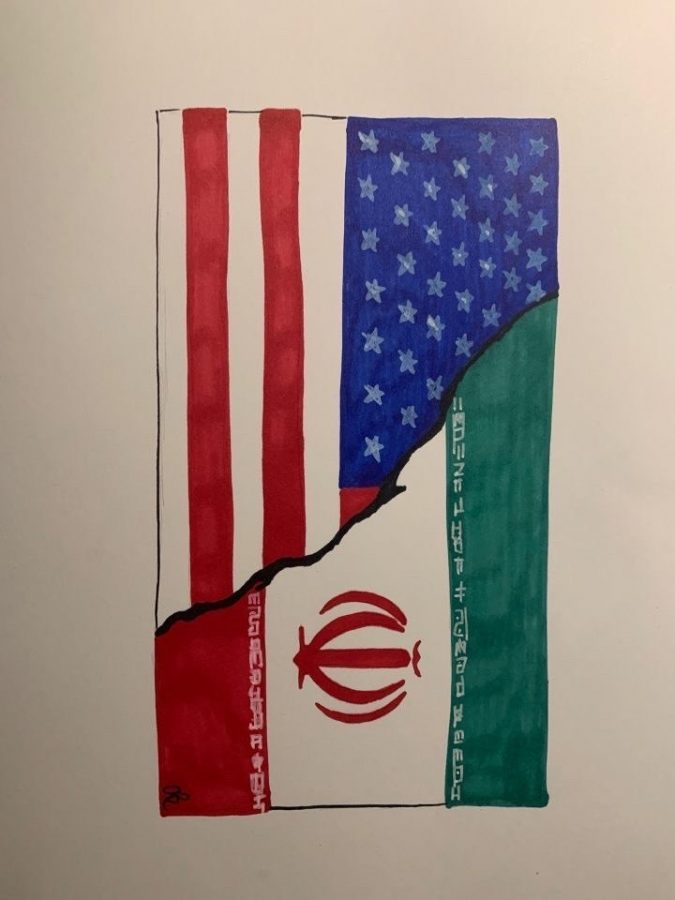The Roots of the Iranian-US Conflict
Deep-rooted issues between the U.S. and Iran have escalated into the most recent military conflict between the two countries. As 2020 began, issues between the U.S. and Iran became a clear problem when President Donald Trump ordered the assassination of a leading Iranian military General, Qasem Soleimani. But where did this all begin? What events led up to a situation so intense that people speculated that a war could potentially break out? All of the conflicts between the two countries are traced back to 1953: the year that the U.S. staged a coup that brought back the Iranian shah, the country’s unpopular monarch, Mohamed Reza Pahlavi.
After struggling to make their voice heard for many years, Iranian nationalists rebelled, and the Iranian Revolution began in 1997. The Iranians made it clear that they wanted to overthrow the American-supported monarchy and form their own national state. They accomplished this, and the Republic of Iran was formed. These nationalists did not wait to avenge the country that had kept their hated monarchy in place for so long; Iranians cheering “Death to America” was heard all around the country. Shortly after the Republic was formed, 52 Americans were taken from the U.S. embassy in Iran and held hostage for over a year. Global Studies Teacher David Rabinowitz recalled this situation and stated, “The tensions between the U.S. and Iran were intense in the late 1970s and early 1980s. I specifically recall the hostage crisis. It seemed to consume the nation. President Carter sent a covert rescue mission to Iran, and it failed, resulting in deaths of US military personnel. That was devastating for all. As a 12-year-old, it seemed to be miraculous that the day Ronald Reagan was inaugurated the hostages were freed; however, I soon learned it was more the Iranian disdain for Carter rather than their support of Reagan.” During the time the hostages were taken, U.S. President Jimmy Carter attempted to isolate the U.S. from Iran. After many failed attempts to rescue the hostages, they were finally released in 1981. This was just the first of the many disputes between the two countries.
As war broke out between Iran and its neighbor Iraq in the 1980s, the U.S. sparked further frustration in Iran by supporting Iraq. This war was an eight-year long conflict in which civilians from both sides of the conflict were targeted. The U.S. displayed its alliance with Iraq through its sale of weapons to Saddam Hussein, the Iraqi leader, who also continuously received weapons from U.S-allies France and Britain. By supporting Iraq in this conflict, the U.S. helped prove that the U.S. and Iran were not on the path to becoming anything close to allies.
A series of violent actions taken by Iran against the U.S. in 1983 intensified the friction. First, the U.S. Marines and U.S. embassy were attacked in Lebanon; Hezbollah, a terrorist organization supported by Iran, killed 258 Americans when they bombed the U.S. embassy in Lebanon and attacked the U.S. Marine Corps in Beirut, Lebanon. Shortly thereafter, another attack on the U.S. embassy in Lebanon left 17 more Americans dead. Months later, suicide bombers attacked the U.S. military barracks in Lebanon, which killed another 241 Americans. These violent killings led to many Americans, including President Raegan, associating Iran with terrorism.
In 1984, Reagan’s Administration named Iran as a state sponsor of terrorism. This distrust of Iran was imprinted in many Americans’ minds, and in 2018, the U.S. State Department further supported this claim by stating that Iran supports terrorist groups, including Hezbollah, Hamas, and the Palestinian Islamic Jihad. The State Department claimed that Iran is the “world’s worst state sponsor of terrorism,” supporting this claim with the fact that the Tehran regime in Iran has spent nearly one billion dollars per year to support terror groups “that serve as its proxies and expand its malign influence across the globe.” Regardless if these statements are biased or unbiased, they reflect the opinions of many Americans, and these negative beliefs contribute to the building conflict between the two countries.
In 1988, the U.S. military made a move that has had a lasting impact on the relations between the two countries. The Iranian Air Flight 655, which was an Iranian passenger jet, was shot down by a U.S. naval ship. This plane was perceived to be an Iranian F-14 fighter jet by the U.S. navy ship, USS Vincennes, that was stationed in the Persian Gulf and issued the strike. This attack was sparked by a few naval conflicts between the two countries, and this led to the death of 290 passengers. Two years later, Iran sued the U.S. for awarding USS Vincennes Captain William C. Rogers with the country’s Legion of Merit award for his service in the military. Eventually, the U.S. settled to give Iran $132 million. While the short-term punishment was monetary, the U.S. has been paying for this conflict ever since, as this event has led to heightened tensions.
In 1990, the U.S. and Iran briefly shared similar thoughts on an issue; they both viewed Saddam Hussein as an enemy when Iraqi forces invaded Kuwait. This invasion was an attempt to gain more control over oil in the Middle East. Both countries were opposed to this occurring, so they were on the same side for a short period of time, but this unity did not last. Shortly thereafter, another U.S. President fueled the fire when he made his opinion about Iran clear. In 1995, President Bill Clinton implemented an oil trade punishment. He explained why he did so when he publicly stated, “Iran’s appetite for acquiring nuclear weapons and the missiles to deliver them has only grown larger…I am convinced that instituting a trade embargo with Iran is the most effective way our nation can help to curb that nation’s drive to acquire devastating weapons and its continued support for terrorism.” By penalizing Iran, Clinton gave the Iranians another reason to have negative feelings towards the Americans.
There is a long list of U.S. presidents who made negative statements about Iran. In 2002, U.S. President Bush coined Iran as part of the “Axis of Evil” that also included Iraq and North Korea. In his first State of the Union address after 9/11, Bush declared, “States like [Iran, Iraq, and North Korea], and their terrorist allies, constitute an axis of evil, arming to threaten the peace of the world. By seeking weapons of mass destruction, these regimes pose a grave and growing danger.” President Bush’s claims followed a series of speculations that Iran was trying to develop and acquire nuclear weapons to use against the U.S., which continued to worsen the tension between the two nations after this announcement.
In 2011, the U.S. obstructed Iran’s plan to kill its enemy, Adel Al-Jubeir, a Saudi Arabian ambassador, in America. It was reported by President Obama’s administration that the Iranian government tried to hire a member of an alleged Mexican drug cartel to bomb a restaurant at which the ambassador regularly ate. Nonetheless, the hired assassin informed the U.S. government of this plan, and the U.S. government was quickly able to thwart Iran’s efforts. This situation may appear somewhat hypocritical as news spreads today about the assassination of Soleimani by the U.S. that occurred in Iraqi territory, which sparked the current conflict.
Trump’s presidency has been filled with conflict between the U.S. and Iran. The first was in 2018, when he backed out of the nuclear deal with Iran. This deal was made in 2015, during President Obama’s presidency, and it led to the removal of the punishments enforced on Iran so long as it cooperated and restricted its nuclear weapons. However, President Trump viewed this deal as “defective at its core,” and re-imposed the penalties on Iran. Shortly thereafter, in 2019, Iran launched a series of attacks in the Middle East, and some were against the U.S. There is no clear correlation between Trump enforcing the punishments on Iran and the following attacks, but this cause and effect is a possibility.
Officially, the attacks began after Iran’s Revolutionary Guard Corps was deemed as a terrorist organization. These assaults included the Revolutionary Guard’s attack on two oil tanks, the destruction of a U.S drone, and a missile and drone attack on a Saudi Arabian oil company in Sept. 2019, which led to the destruction of 5.7 million oil barrels. Additionally, in Dec. 2019, an American defense contractor was killed by an Iranian-backed rocket attack. On New Year’s Eve, President Trump accused Iran of planning to attack the U.S. embassy in Baghdad. All of these conflicts built up into a major ambush that occurred shortly after the New Year.
On Friday, Jan. 3, 2020, President Trump ordered U.S. forces to assassinate Iran’s top military general, General Soleimani. The assassination occurred via a drone strike on Soleimani when he was at the Baghdad airport in Iraq. Following this attack, Iran launched counter attacks, and tension between the U.S. and Iran has since risen, leading some to believe that these conflicts will soon escalate into a full-fledged and long-speculated war between the two countries. The future actions of the two countries are currently unknown. Government Teacher Kimberly Herrmann commented, “Probably what is going to happen is Iran is going to continue to go through economic struggles, and with them admitting that the Ukrainian flight was their fault, lucky for Trump, the Iranians will relax a little bit.” She also went on to express that she thinks that “there will be tension until the leaders find a solution.” Senior Ethan Renz explained that he thinks that “the situation has certainly de-escalated, and the maximum pressure campaign brought on by the Trump Administration will lead to an eventual modern nuclear deal.” He added, “Trump doesn’t want war with Iran; he wants a shiny deal, and I think he’ll work for that.” Unlike Renz, US History Teacher John Cornicello fears nuclear war could be a very real possibility: “The tension between Iran and the U.S. is scary because the threat of a major war is real. Although nuclear weapons have not been used since the end of World War II,the technology is in place and could be a reality, which is frightening…. minor conflicts can always turn into global events if cooler heads do not prevail. We can only hope that, as has been the case in the past, the leader of our country sees us out of this safely with minimal casualties.” One thing is clear, if tensions continue to escalate between the two countries, there will not be any winners.

I am Emma Ward, and I am the News and Opinions online editor for Horizon. In my free time, I enjoy playing tennis, working out, and hanging out with my...







































